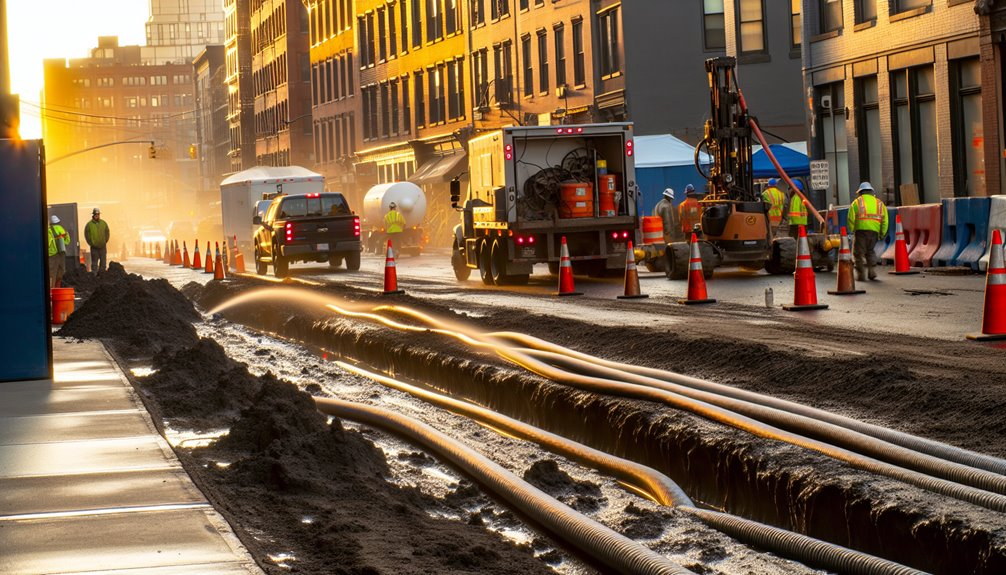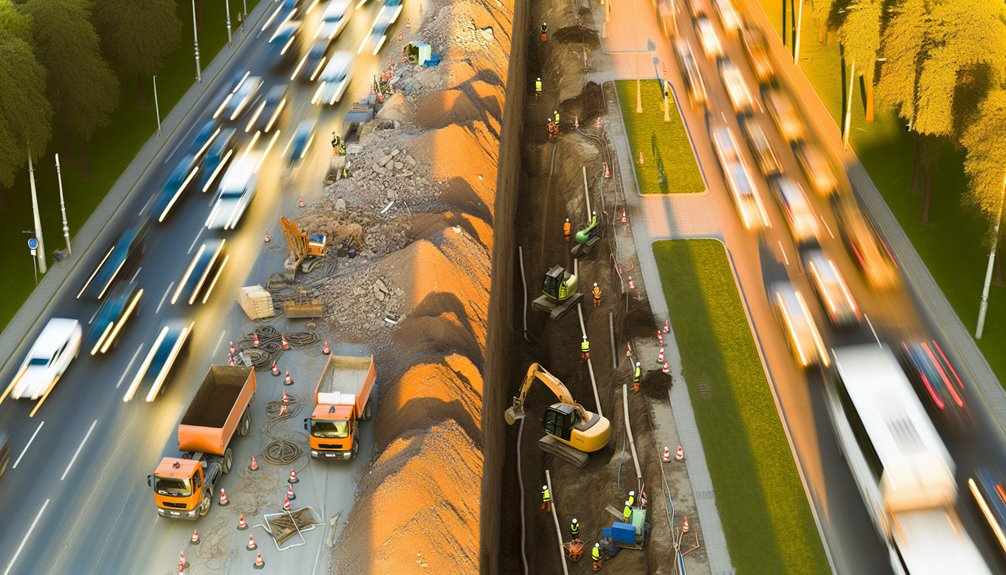You’re planning conduit in a tight corridor where cut‑and‑cover won’t fly, so you need trenchless methods that satisfy NEC cover, minimum bend radius, and utility clearances while minimizing surface impacts. You’ll weigh HDD, guided boring, microtunneling, and pipe bursting against geotechnical baselines, traffic staging, and permitting windows, then control risk with calibrated guidance, real‑time annular pressure and pull‑load limits, and QA/QC stop‑work triggers—because the success criteria start long before the pilot bit turns…
Why Trenchless Methods Matter in Dense Urban Environments

Because surface disruption is costly and risky in tight streets, trenchless conduit installation lets you route feeders and telecom laterals under pavements, rails, and utilities with minimal excavation and permits. You reduce traffic conflicts, protect emergency access corridors, and maintain ADA routes.
By adhering to NEC raceway fill, burial depth, and separation from gas, water, and fiber per local amendments, you mitigate cross-utility hazards. You also limit groundwater intrusion and settlement by following ASTM F1962 and geotechnical pre-clearance practices.
You’ll strengthen community engagement by sharing haul routes, work windows, and noise controls, and by scheduling tie-ins off-peak. Utility strike risk drops when you validate locates with EM and GPR and pothole conflict points.
Document as-built alignments with survey-grade GNSS, update GIS, and close permits cleanly.
Selecting the Right Technique for Corridor Constraints and Loads
With surface impacts minimized and utility conflicts verified, you next match the trenchless method to corridor geometry, soils, and structural demands.
Start by quantifying cover, clearances, bend radii, and entry/exit windows; confirm allowable tolerances against local standards and owner criteria.
Evaluate geotechnical data for strength, abrasivity, void risk, and groundwater; set dewatering and pressure limits accordingly.
Align conduit size, wall class, and joints with anticipated load ratings from traffic, surcharge, and thermal cycles.
For tight radii or shallow cover, consider microtunneling or pipe jacking; for short, straight shots beneath sidewalks, auger boring or guided ramming can fit the corridor geometry.
Specify casing where uplift or point loads are critical.
Document method selection via a risk register, method statement, and inspection test plans.
Horizontal Directional Drilling: Steering, Tooling, and Accuracy

Although HDD offers flexibility in congested corridors, accuracy depends on disciplined steering, fit-for-purpose tooling, and real-time verification against a defined bore path.
You start by locking alignment and tolerances in the pre-bore plan, then choose bits, reamers, and mud programs matched to lithology and conduit diameter.
Use walkover systems or wireline guidance with sensor fusion to combine magnetics, gyros, and pressure data; validate with string tracking and surface control points at defined intervals.
Maintain drill-face control with incremental steering corrections, low doglegs, and rotation/flow setpoints that meet utility separation and bend-radius criteria.
Calibrate sondes daily, record as-built shots, and reconcile deviations immediately.
Standardize QC logs, fluid properties, and pullback loads so every crew member hits the same accuracy targets.
Microtunneling: Remote Guidance for Deep, Congested Alignments
Even when utilities stack in multiple tiers and cover is deep, microtunneling lets you drive a precise line and grade from a launch shaft using a remotely guided, pipe-jacked MTBM. You maintain control with laser guidance, gyros, and remote telemetry that closes the loop on steering, thrust, torque, and slurry parameters. You’ll specify jacking forces, settlement criteria, and annulus grout per ASTM and EN standards, validating tolerances with as-built surveys.
In mixed ground, you manage face pressure, cutterhead speed, and slurry density to prevent heave or loss. You build operator redundancy into the control room and comms, ensuring continuity if a node fails. You coordinate utility strikes avoidance with thorough potholing, vacuum extraction, and real-time conflict alerts, safeguarding conduits and schedule.
Pipe Bursting: Upsizing and Replacement Without Surface Disruption

Step in to replace or upsize buried conduits along the existing alignment by pulling a bursting head through the host pipe and immediately installing a new HDPE, PP, or ductile iron carrier behind it.
You’ll verify utility clearances, evaluate soil density, and select static or pneumatic systems per NASTT and NASSCO guidance.
Calculate pull forces, upsizing ratios, and rod tensile limits; confirm sDR selection for anticipated surcharge.
Execute pit shoring, pipe string fusion, and continuous monitoring of line/grade tolerance.
Manage heave risk with controlled advancement, slit knives, and real-time pressure logs.
Integrate groundwater management—dewatering or wellpoints—to stabilize pits and prevent float.
Maintain stakeholder communication with residents, traffic agencies, and facility owners.
Document as-built data, pressure tests, and corrosion protection.
Guided Boring and Pilot Tube Methods for Short, Precise Crossings
When upsizing or replacing along an existing corridor isn’t feasible, use guided boring and pilot tube methods to place short, high-accuracy crossings with millimetric control. You’ll establish pilot alignment with a theodolite or laser theodolite and maintain it through guided surveying at every rod. This approach meets tight electrical conduit tolerances, minimizes heave, and protects pavements and rails.
- Plan: Define line/grade, allowable bend radii, separation from structures, and casing–conduit interfaces per NEMA TC-7 and NEC Article 300.
- Set control: Build a stable datum, verify prism/target offsets, and close your traverse to confirm millimetric closure.
- Execute: Advance pilot tubes, monitor thrust/torque, and ream only as required for the selected casing OD.
- Validate: Record as-built line/grade, confirm annulus and pullback tensions, and document QA per ISO 9001.
Subsurface Data: Utility Mapping, GPR, and Potholing Strategies

Although trenchless methods minimize surface disruption, you still need defensible subsurface intelligence before you drill. Start with utility mapping that fuses records, survey control, and GPR in multiple frequencies to resolve depth and material contrasts.
Complement with EMI and thermal imaging to differentiate energized circuits and recent backfill. Build subsurface models tied to a common datum, then run clash analyses against your planned bore path.
Execute potholing (vacuum excavation) at high‑risk crossings to ISO/ASCE utility quality levels, documenting locations with as‑built verification and photos. Calibrate GPR interpretations using pothole data and update the model in real time.
Conduct stakeholder outreach with utilities, city asset owners, and adjacent projects to close data gaps and schedule isolation where required. Archive datasets, chain‑of‑custody, and metadata for auditability.
Risk Management: Geotechnical Variability, Settlement, and Strikes
Even with robust subsurface intelligence, you must manage residual risks from variable soils, ground movements, and third‑party asset strikes through a formal, standards‑aligned framework. Anchor your risk posture in ISO 31000 and IEC 31010, integrate a geotechnical baseline report, and explicitly codify strike prevention. You belong to a profession that shares data, learns fast, and protects communities.
1) Establish the geotechnical baseline: define anticipated stratigraphy, strength ranges, groundwater envelopes, and tolerable variability; tie tooling, drilling fluids, and thrust limits to that baseline.
2) Model settlement: use cavity expansion and elastic‑plastic ground response methods; set trigger levels and preapprove mitigation (grouting, lubrication, annulus control).
3) Execute strike prevention: ATU Class A locating, electromagnetic/sonde cross‑checks, lockout distances, and hold‑point verifications.
4) Control change: run formal MoC for deviations, update risk registers, and brief field crews.
QA/QC and Monitoring: Tracking, Pullback Forces, and As‑Built Verification

Routinely treat QA/QC and monitoring as a real‑time control loop that proves conformance and protects assets. You’ll align field decisions with specifications by integrating gyroscopic or walkover tracking, calibrated load cells for pullback, and high‑resolution bore path surveys. Use real time logging to capture drill head position, annular pressures, and fluid returns; set alert thresholds tied to design envelopes and stop‑work criteria.
Implement tension monitoring during reaming and product pull to verify maximum allowable pulling forces, side‑load, and bend radii per cable and conduit manufacturer limits. Correlate force spikes with soil lenses and tooling changes.
For as‑built verification, fuse tracker data, rod count, and utility surveys into a georeferenced model; validate tolerances, cover, separation, and curvature. Issue sealed as‑built reports and traceable QA records.
Permitting, Traffic Control, and Stakeholder Coordination in Urban Settings
Before you break ground in a congested corridor, lock down a permit strategy that sequences approvals, traffic control, and notifications to keep the drill window predictable. Align permit timelines with utility locates, HDD launch windows, and night or weekend work allowances. Build a matrix of agency conditions, MUTCD-compliant traffic staging plans, and emergency access provisions so inspectors see readiness, not risk.
- Map permit timelines to design milestones; pre-file traffic staging variants for detours, lane drops, and flagging under peak-hour restrictions.
- Formalize stakeholder engagement: transit, emergency services, businesses, and residents; capture constraints and publish responses.
- Execute public outreach with plain-language notices, 511 updates, and storefront briefings; provide two-way channels.
- Schedule inspections, steel-plate restoration, and noise/vibration monitoring; document compliance and escalate deviations fast.
Conclusion
As the owner of Boring Bros., I take pride in using trenchless methods that respect urban constraints without cutting corners—matching HDD, guided boring, microtunneling, or pipe bursting to loads, cover, and bend radii to keep disruption and risk to a minimum. We combine GPR, EMI, and potholing, calibrate guidance systems, and enforce geotechnical baselines with clear stop‑work triggers; we track head position, annular pressures, and pull loads, keep thorough QA/QC logs, and seal as‑builts into GIS. With disciplined permitting and thoughtful traffic staging, we deliver safe, compliant, and verifiable conduit installations. If you’d like to learn more, please visit boringbro.com or give us a call at (954) 639-6167—I’d love to talk about your project.




